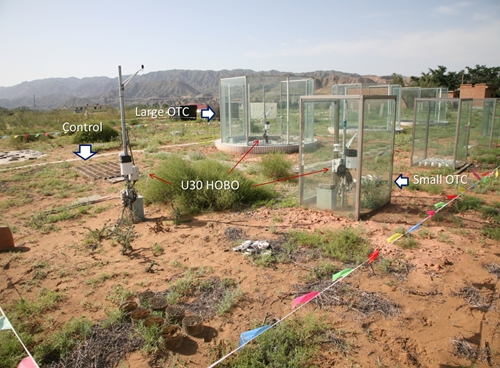Scientists Reveal Hydrological Response of Biological Soil Crusts to Global Warming
Updatetime:2018-07-24From:
【Enlarge】【Reduce】
Biological soil crusts (BSCs) across the desert regions are autotrophic communities composed of cyanobacteria, algae, fungi, lichens and mosses, which regulate many functional processes of desert ecosystems and play a key role in regional ecological security and ecological health.
However, due to very few studies involved the relationships between climate change and global hydrological functioning of BSCs, therefore, it remains unclear how changes in the interspecific relationships of BSCs and community characteristics (cover and biomass) contribute to hydrological functioning, and the responses to warming and decreased precipitation.
Recently, scientists from Northwest Institute of Eco-Environment and Resources used open-top chambers over a 10-year period to simulate warming and reduced precipitation.
They measured infiltration, dew entrapment and evaporation as surrogates of the hydrological functioning of biological soil crusts and evaluated how the hydrological properties of these biological soil crusts respond to temperature and precipitation alterations.
It was found that the ongoing warming coupled with reduced precipitation will more strongly affect moss in crustal communities than lichens and cyanobacteria, which will lead to a direct alteration of the hydrological performance of biological soil crusts.
Besides, reductions in moss abundance, surface cover, and biomass resulted in a change in structure and function of crustal communities, decreased dew entrapment, and increased infiltration and evaporation of biological soil crusts in desert ecosystems, which further impacted on the desert soil water balance.
The aim of this study is to investigate whether warming substantially reduces crustal biomass, surface cover and species richness in crustal communities, as well as the hydrological functioning of BSCs.
The study entitled “Hydrological response of biological soil crusts to global warming: A ten-year simulative study” was published in Global Change Biology.

The different sizes of Open-Top Chamber were employed to simulate warming (photo in 2007) (Image by LI Xinrong)
Contact:
LI Xinrong
Email: lxinrong@lzb.ac.cn
Shapotou Desert Research and Experiment Station, Northwest Institute of Eco-Environment and Resources, Chinese Academy of Sciences, Lanzhou 730000, China.
Appendix




